


At his press conference on Tuesday, January 16, French President Emmanuel Macron spoke of a "major plan to combat infertility." One of the causes of difficulties in conceiving a child is contact with chemical substances that are omnipresent in the domestic environment, the food chain and certain medicines. This connection has been established beyond reasonable doubt by hundreds of scientific publications. But the number and diversity of suspicious molecules, the multiplicity of exposure routes (food, inhalation, skin contact, etc..), and the sometimes lengthy time lag between exposure and the onset of infertility make it extremely complicated to estimate the extent of these effects and identify the main products responsible.
The most well-established effects are on male fertility. Worldwide, average sperm concentration in human semen has been halved in half a century, according to the latest analysis of all available data.
Published in June 2022, the first studies attempting to establish a hierarchy of the main contributors to this decline indicate that the top spots are occupied by bisphenols (present in rigid plastics and resins in contact with food), polychlorinated dioxins (emitted by household waste incinerators in particular) and certain phthalates (present in soft plastics). Parabens (present in certain cosmetics and hygiene products), as well as paracetamol (a widely-used analgesic), were also singled out by the researchers.
But beware: The major effects of these substances occur with a delay, after exposure in utero, through mothers during pregnancy. These hormone-disrupting substances (or "endocrine disruptors") act particularly during the construction of the reproductive system, reducing the future fertility of the unborn child. Political timescale is not biological timescale. Regulatory measures taken today to reduce people's exposure to these endocrine disruptors would have significant effects on fertility for the next generation – although other positive health effects may become apparent much sooner.
Agrotoxins and endometriosis
A summary of the available scientific literature, published in November 2023, showed that exposure to pesticides from the organophosphate and carbamate family reduced sperm concentration in the semen of individuals exposed throughout their lives, not just in utero.
Pesticides used in conventional agriculture, which quietly find their way into food, are also suspected of playing a damaging role in female reproductive health. In its collective expertise published in June 2021, the French National Institute for Health and Medical Research (INSERM) highlighted several studies associating certain families of agrotoxins with endometriosis – a disease that increases female infertility and affects 5% to 10% of women of childbearing age. More generally, INSERM experts noted that since certain hormones, particularly estrogens, were "suspected of being involved in the pathological processes at the origin of endometriosis," it was "logical to suspect certain endocrine disruptors as environmental agents" being involved in these diseases.
You have 25% of this article left to read. The rest is for subscribers only.
